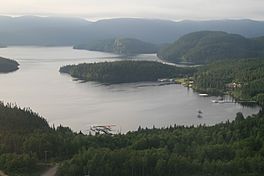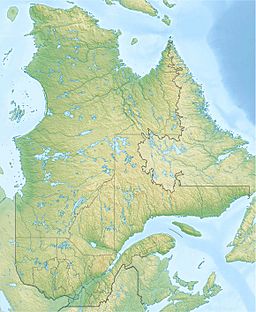Lake Sainte-Anne (Toulnustouc) facts for kids
Quick facts for kids Lake Sainte-Anne |
|
|---|---|

Kami Property on the lake, with airplanes
|
|
| Coordinates | 50°09′04″N 67°54′33″W / 50.151202°N 67.909072°W |
| Native name | Lac Sainte-Anne Error {{native name checker}}: parameter value is malformed (help) |
| River sources | Toulnustouc River |
| Basin countries | Canada |
| First flooded | 1950 / 2005 |
| Surface area | 23,400 hectares (58,000 acres) |
| Surface elevation | 301.74 metres (990.0 ft) |
Lake Sainte-Anne, also known as Lac Sainte-Anne in French, is a large lake and reservoir in Quebec, Canada. It's located on the Toulnustouc River in the area called Côte-Nord. This lake is important because it helps power several hydroelectric plants, which make electricity for people.
The lake has changed over time. An original dam was built in 1950 to control the river's water flow. This was part of a bigger project to create electricity from the Manicouagan River. Later, in 2005, a new, larger dam was finished. This new dam made the lake even bigger and helps power a new electricity-generating station called the Toulnustouc generating station.
Contents
The First Dam at Lake Sainte-Anne
The first reservoir for Lake Sainte-Anne was created when the Sainte-Anne Dam was filled in 1957. This dam was built to control the amount of water flowing in the Toulnustouc River. This controlled flow was important for other hydroelectric plants downstream. These plants included the Manic-2, Manic-1, and the older McCormick plants.
The first reservoir covered an area of about 213 square kilometers (82 square miles). The Manic-1 and Manic-2 plants are owned by Hydro-Québec, a large electricity company in Quebec. The McCormick plant is owned by the Manicouagan Hydroelectric Company. The Manic 2 generating station is located near Baie-Comeau, where the Manicouagan River meets the Saint Lawrence River.
Before the new dam was built, Lake Sainte-Anne's water level would reach its highest point in spring. It would stay high during the summer. Then, it would shrink down to its lowest level by early May. There was also a special wall, called a dyke, in the southeast part of the lake. This dyke was fixed to stop water from leaking out when the new dam project started.
Building the New, Bigger Dam
A new dam and dyke were built for the Toulnustouc hydroelectric project. The goal was to make the existing Lake Sainte-Anne reservoir much larger. The old dam was further up the river, while the new dam was built further downstream.
The new dam is about 76 meters (249 feet) high and 570 meters (1,870 feet) long. This new structure greatly increased the amount of water the reservoir could hold. The lake's area is now about 23,400 hectares (90 square miles). The area of land that drains water into the lake is about 7,863 square kilometers (3,036 square miles).
The new dam and dyke are located about 14 kilometers (9 miles) downstream from where the first dam was. The south dyke is in a valley and helps hold the water in that part of the reservoir. A tunnel was also built from the end of the south dyke. This tunnel carries water to the hydroelectric plant, which is even further downstream. Once the new dam was closed and working, the old dam was taken down.
How the New Dam Changed the Lake
With the new dam, the highest water level of Lake Sainte-Anne stayed the same. However, the lowest water level was raised. This means the lake always has more water in it now than it used to.
The new part of Lake Sainte-Anne started filling up on February 10, 2005. In just five days, the water level rose by 57 meters (187 feet)! After that, the filling continued more slowly, rising by about 1 to 2 centimeters (0.4 to 0.8 inches) each day. By the start of summer 2005, the lake had reached its highest normal operating level. The lake expanded by about 18 square kilometers (7 square miles), making it larger than 230 square kilometers (89 square miles) in total.
Impact on Wildlife Around the Lake
The flooding from the new dam had some effects on the animals living near the lake. Only one moose had to move to a new winter home. Smaller animals like hares, porcupines, squirrels, martens, otters, and beavers moved safely to avoid the rising water. They found new places to live in the forest around the edge of the expanded lake. Predators like wolves, foxes, and lynx walked along the new waterline, looking for food. Overall, the impact on wildlife seemed to be small.
Impact on Fish in the Lake
For five days, the water flow between the dam and the spillway was stopped. Then, water started flowing again, but at a slower rate. Scientists checked the fish in the summer of 2005. They found that the number of fish in the reduced flow area had not changed much.
In the new, deeper parts of the lake, there was less oxygen. Also, there was more phosphorus in the water at all levels. These changes happened because plants that were not cleared before the flooding started to break down. Scientists expected these effects to go away after a few years.
Good news for the fish! Measurements in the summer of 2005 showed that fish quickly moved into the new parts of the lake. Scientists took fish samples in 2005, 2007, and 2009. They recorded the length, weight, and any unusual things about the fish, especially brook trout. The results showed that the number and size of fish in the river and the reservoir were not negatively affected. In fact, some fish were even larger than before!


